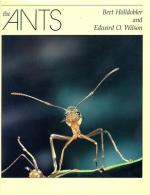|
This section contains 1,245 words (approx. 4 pages at 400 words per page) |

|
"A 'supercolony' of the ant Formica yessensis on the Ishikari coast of Hokkaido was reported to be composed of 306 million workers and 1,080,000 queens living in 45,000 interconnected nests across a territory of 2.7 square kilometers." Chapter 1, p. 1
"All known living ants are eusocial, with strong physical differences separating the queen and worker castes. Thus a large gap in social behavior remains between even the most primitive ants ... and their closest living relatives..." Chapter 2, p. 27
"As expected, mother queens live much longer than workers in all groups of ants. The astounding figures for longevity of Camponotus, Formica, and Lasius queens, ranging from 18 to 29 years, make these ants the most long-lived insects ever recorded." Chapter 3, p. 170
"By almost any conceivable standard, the single most important feature of insect social behavior is the existence of the nonreproductive worker caste." Chapter 4, p. 179
"The ability to distinguish nestmates from strangers is vital to social life...
|
This section contains 1,245 words (approx. 4 pages at 400 words per page) |

|




